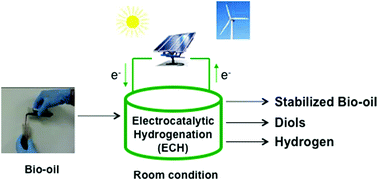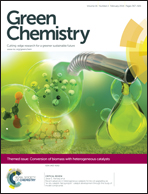A mild approach for bio-oil stabilization and upgrading: electrocatalytic hydrogenation using ruthenium supported on activated carbon cloth†
Abstract
Electrocatalytic hydrogenation (ECH) offers a new approach for bio-oil stabilization (a.k.a. partial upgrading). Water-soluble bio-oil, obtained by aqueous extraction of the liquid product of biomass pyrolysis, was hydrogenated using ECH at room conditions. A new electrocatalyst, ruthenium supported on activated carbon cloth, was used as the catalytic cathode. After electrocatalytic hydrogenation, aldehydes and ketones were reduced to the corresponding alcohols or diols, forms less prone to condensation chemistry. Carbon recovery into the liquid product, important when making liquid fuels from biomass, was more than 80%, while less than 0.1 wt% of the water-soluble bio-oil formed solid precipitate. The stability of the ECH-treated water-soluble bio-oil was checked via an accelerated aging test followed by size exclusion chromatography analysis and viscometry. Besides stabilization of bio-oil for subsequent fuel production, hydrogen and valuable diols were produced during ECH. Strategies to optimize the energy efficiency of this approach by altering the cell design, modifying the catalyst and adjusting the reaction conditions were also explored.

- This article is part of the themed collection: Conversion of biomass with heterogeneous catalysts

 Please wait while we load your content...
Please wait while we load your content...